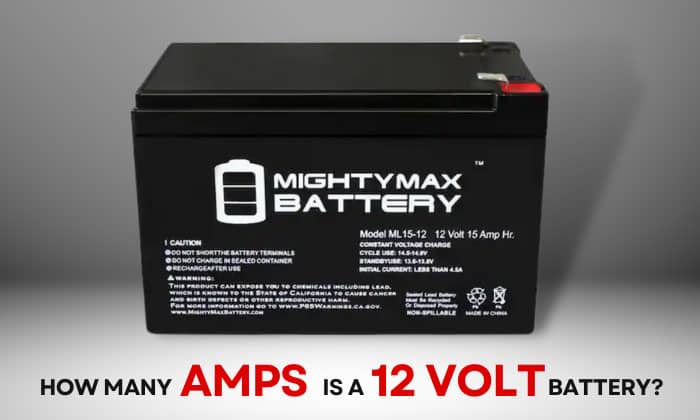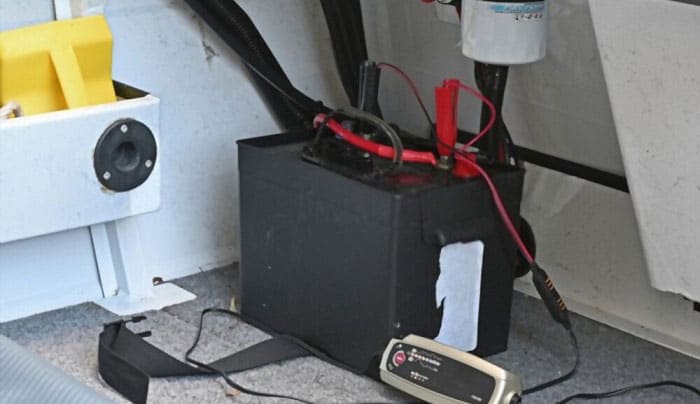Batteries come in different configurations for varying needs, such as starting the engine of speed boats and RVs or running their appliances. The most commonly used battery for vehicles is 12 volt.
When buying it, a feature to look at is the 12v battery amperage. Generally, 12 volt battery amps can go as high as 1000 for certain models, but the device’s purpose will determine how many amps is a 12 volt battery.
Table of Contents
12-Volt Battery – How Many Amps?
The purpose of the battery will determine the right characteristics to look for. The battery needed to start a gas-powered car is different from one that runs electrical equipment in an RV or a boat.
Regular lead acid batteries are used to crank vehicles. These have an average CCA of 800, which is how much a car battery needs to start engines in many cases. Smaller 12 volt battery output of 600 CCA are used for smaller cars, while up to 1000 suits trucks and SUVs.
As for Ah, these devices commonly have between 45-65 amp hours.
Also, regular lead acid batteries are not intended to be drained completely. They normally use only around 3% of their capacity at a time, and expend only up to 20% of their charge when connected to the car’s alternator.
Another kind of lead acid battery is the 12 volt deep cycle battery. These are used for vehicles that need large amounts of current for longer periods of time, such as golf carts and RVs. They have thicker plates than regular lead acid batteries, which allow them to serve their purpose.
Because deep cycle batteries need to run longer, they usually have 2-3 times the reserve capacity of regular lead acid batteries. However, they have around half the CCA of their regular counterparts.
A specific type of lead acid batteries is the 12 volt marine battery. This kind of battery is designed for boats, which experience constant vibrations and wave onslaughts. They come as starter versions or as deep cycle versions, depending on what is needed, but both can be present, especially when the boat has a trolling motor.
What is the Ampere Rating of a Car Battery?
Car batteries can have an amperage rating of 550 amps to 1000 amps. It depends on the car types and sizes, as well as the battery itself, including chemistry, capacity, and other specifications that help measure the amp rating. Read below for more information.
Specifications of a 12 Volt Battery
The first characteristic to look at is its amp-hours, expressed in Ah. The amp-hour is a measure of how much current the battery can produce in a certain amount of time. The higher the amp-hour rating, the larger the battery capacity would be.
In theory, if a 12 volt battery is rated at 80 Ah, this means it can deliver 80 amps in an hour. It may also deliver 40 amps in 2 hours or 20 amps in 4 hours.
Read now a detailed guide on calculating amp hours of a battery exactly here!
However, batteries may have different amp-hour ratings at a certain number of hours. If the specification is written as C20=80 Ah, this means the device is rated at 80 Ah if discharged within 20 hours.
The second feature to look at is the cranking amps, or CA. This is the amperage of a car battery generated in a short time, usually 30 seconds at 0 degrees Celsius. The higher the CA in an amperage chart, the more current it gives in a short burst.
A similar rating to CA is the cold cranking amps, or CCA. Instead of looking at the current at 0 degrees Celsius, CCA looks at the current at -18 degrees Celsius (or 0 degree Fahrenheit). This is a good rating to check when the vehicle is in a cold climate.
The third value to look at is the reserve capacity, or RC, expressed in minutes. This rating shows how many minutes the battery has left before its voltage drops from 12 to 10.5 volts (at which point the battery has depleted its capacity). The larger the reserve capacity is, the longer the battery can run.
Frequently Asked Questions
What is an amp-hour chart on a car battery?
- Maybe you’re referring to the battery label. It is the sticker on the battery that contains information like the voltage, CA, CCA, reserve capacity, amp-hours and other data like the battery type (deep cycle, for instance).
- You might also be referring to the state-of-charge vs voltage chart of a battery. It tells us how many voltage a model has and its corresponding capacity. A typical lead-acid design will have 100% capacity at 12.6 volts and 0% capacity at 10.5 volts.
- Take note that the power of the battery comes from the car battery volts and amps, so the output becomes lower as it discharges.
How many amps and hours are needed to charge a 12 volt battery?
It depends on the kind of charger and the amp-hour rating of the battery. 2 amps can be drawn from a basic car battery charger, so an 80 Ah battery will need 40 hours of charging time to go from 0% discharged to 100% full.
You can perform similar calculations for other battery capacities and chargers. For instance, 80 Ah devices will be full within 10 hours if charged at a rate of 8 amps/hour.
Can I use a higher amp charger on my car battery?
You may run the risk of damaging your car battery with higher amps. A good estimate of a suitable car charger would be around 10% of your amp-hour battery rating.
Conclusion
How many amps is a 12 volt battery? Different models will have varying ratings.
If the vehicle needs a burst of current in a short time, then a regular lead acid battery with a high CA or CCA is enough, especially if it can produce as much as 1000 amps. If the vehicle needs a continuous stream of current for longer periods like an RV, then a deep cycle battery with high reserve capacity should be used.
Read next: How Many Amps Does a AA Battery Output?

I am Edwin Jones, in charge of designing content for Galvinpower. I aspire to use my experiences in marketing to create reliable and necessary information to help our readers. It has been fun to work with Andrew and apply his incredible knowledge to our content.



